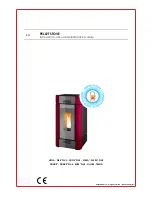
POÊLE À GAZ GODIN ref. 3428
8
Whether you build a masonry or a factory-built chimney keep as much of the chimney as
possible inside the house. This is an important point: an inside chimney wastes less heat to
the out-of-doors. Because it stays warmer, it provides a more constant draft, and less
creosote condenses on its inside surfaces.
If the design of your house, or the location of your stove requires you to install a factory-built
chimney up the outside of your house, and you live in a cold climate, enclose the chimney in
an insulated, wood-frame chase. Follow the chimney’s manufacturer’s instructions and local
building codes. Construct a removable panel at the bottom so you will have access to the
chimney’s clean-out tee.
Before firing your stove, ask your local building or fire official to inspect the installation.
Remember, stove and chimney must work together as a system. If the stove cannot heat the
chimney sufficiently because the chimney is too cold, the system will not function properly.
A chimney cap keeps out rain, contains sparks and reduces downdrafts. All factory-built
chimney manufacturers offer compatible caps made. A variety of metal caps, as well as
traditional fired clay chimney ‘pots’ can be purchased for masonry chimneys.
STOVEPIPE (CHIMNEY CONNECTOR)
Stovepipe (also called chimney connector) is used to convey the smoke and gases from the
stove to the chimney. It is a link in the continuous draft system that draws combustion air into
the stove and the products of combustion out the chimney.
CAUTION:
Stovepipe must never be installed through walls, ceilings, or roof, but only in the
room where the stove is located, where it should be visible to inspection. Penetrations of
walls, ceilings or roof must be made only with listed factory-built, low-heat appliance chimney
installed in accordance with the manufacturer’s instructions.
Restricting the use of stovepipe to the room where the stove is located increases the
likelihood that corrosion, mechanical failure or creosoting of the pipe will be detected. It also
reduces the chance that combustible objects will be stored too near the pipe. Also, it prevents
a common cause of house-fires: ignition of combustible by hot, single-wall pipe passing
through a wall, ceiling or roof.
To improve draft, a run of stovepipe should be as short and straight as possible. Avoid using
more than two elbows. Horizontal pipe should slope upward to the chimney at a rate of ¼ inch
per foot. Do not use galvanized steel pipe. We recommend you use a 5 in diameter stovepipe.
Larger diameter stovepipe has more surface area and dissipates heat more rapidly; it may
reduce the draft and impair the performance of the stove. Stovepipe usually has one plain end
and one crimped end. Install stovepipe so that the crimped end fits toward the stove.

































